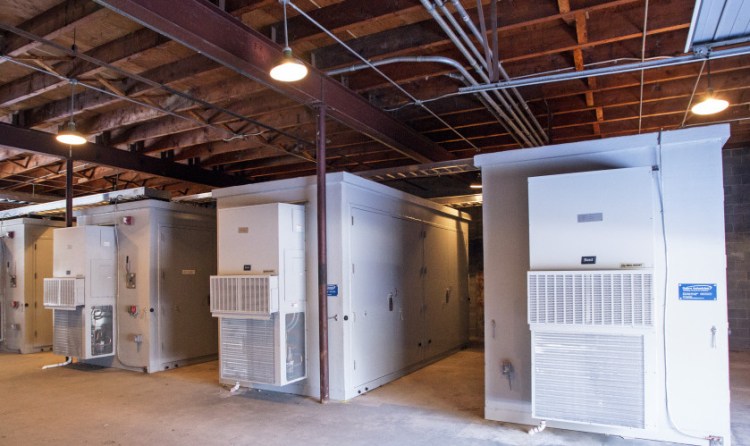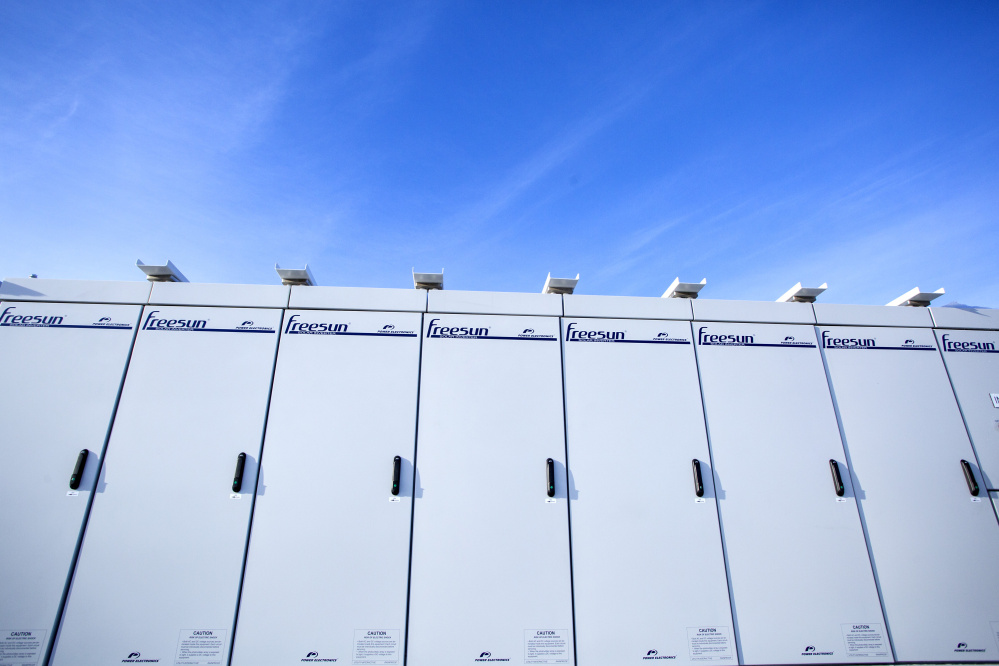New England’s largest battery project – the size of eight shipping containers – is set to begin operating in the next week or so at the Wyman Station power plant in Yarmouth.
The project is part of an industry-wide trend to use battery storage to moderate power supply to the grid, potentially lowering electricity prices for consumers. In other instances, including potential projects in Maine, batteries can store the intermittent power generated by wind and solar, which are affected by the weather.
NextEra Energy Resources, Wyman Station’s lead owner and operator, has installed 1,300 lithium ion modules – a giant lithium battery – in a warehouse at the oil-fired power plant. The project is designed to offer the region’s grid operator, ISO-New England, a more cost-effective way of handling the daily changes in supply and demand than calling for electricity from large gas-fired power plants.
The project also foreshadows a greater role for big batteries over time.
Historically, electricity had to be used the instant it was generated on the grid. One obstacle to integrating large solar and wind projects is that operators need to constantly account for cloudy periods or sudden drops or surges in wind speed. Storing the output from solar and wind power in batteries can smooth those ups and downs, a potential game changer for clean energy.
“Battery storage is the holy grail of the renewables business,” said Jim Robo, CEO of NextEra, speaking at a utility conference last year.
NextEra is among the world’s largest renewable energy companies. Last year, it announced plans to invest $100 million in energy-storage systems to back up its fleet of solar and wind energy plants. Those could eventually include wind farms in western Maine.
NextEra has filed intentions with ISO-New England to install battery units at two wind farms it wants to build near Eustis in Franklin County. Documents filed by NextEra show it wants onsite batteries to suck up excess power when the wind is blowing, and discharge it when demand peaks and the cost of energy is high, such as on a cold, winter afternoon.
NextEra already operates similar battery storage projects next to wind farms in Pennsylvania and Illinois, a decommissioned wind farm in Pennsylvania and near a solar array in New Jersey.
“We expect (storage) to be a much larger part of the grid in the next five years,” Vijay Singh, NextEra’s executive director of business development for energy storage, said in an interview with the Portland Press Herald.
Battery storage is superior to running power plants to regulate the grid, Singh said, because it can be simply scaled up or down, doesn’t use fuel and can be quickly turned on and off.
Innovation and the falling cost of battery technology, tied to the global interest in developing electric cars, is driving the move to energy storage in the power sector. Energy companies across the country are building and planning projects at a rapid pace.
The largest lithium ion battery in the world is being installed in southern California to store renewable energy and blunt a natural gas shortage. In Massachusetts, a state agency is recommending that 600 megawatts of energy storage be installed by 2020, which together could equal the output of a large power plant.
STABILIZING THE GRID
Although the battery array at Wyman Station is the largest in New England, it’s not the first in Maine. Last year, a project roughly one-fifth the size of Wyman’s was installed in Boothbay as part of Grid Solar’s pilot program to meet the need for power in the area without building a new transmission line.
NextEra chose Wyman Station for its first project in New England because the site has available space and a direct connection to big transmission lines. Inside a warehouse, eight metal cabinets that look like 25-foot-long shipping containers hold the battery. Outside, a bank of inverters converts the power to alternating current.
Wyman runs on oil. Its generators have a combined capacity of 822 megawatts, enough energy to power more than 800,000 homes. Although it runs infrequently, Wyman is an important resource for ISO-New England’s power grid. On very cold days, demand for natural gas is so high that oil-fired plants such as Wyman are needed to maintain a reliable power supply.
The battery project at Wyman Station is rated at 16.2 megawatts. By comparison, ISO-New England needs between 30 and 100 megawatts of variable power on a typical day to regulate the system. The battery can run continuously and be charged and discharged as needed with electricity from the grid.
New England’s electricity is produced through a competitive, wholesale market, which means that power generators make their best bids to ISO-New England each day for energy and price. NextEra expects the Wyman Station battery to be less expensive at many times, compared to adjusting a large, gas-fired power plant up and down to regulate output on the grid.
The two western Maine wind farms envisioned by NextEra could be connected to the grid by a new transmission project proposed by Central Maine Power, called the Maine Clean Energy Connection. The wind farms lost a bid competition in October to gain regional utility contracts.
Documents for NextEra’s bids show that the Alder Stream Wind Energy Center would have an overall capacity of 216 megawatts. The Moose River Energy Center is rated at 245 megawatts. Based on the typical capacity of a wind farm, these projects could make enough power to serve roughly 66,000 homes.
Each would be designed to produce 25 megawatts for up to four hours and could send power into the grid at times of peak demand, NextEra says in its documents.
Both wind farms and the transmission line were bidders this year in a competition to provide clean energy to utilities in southern New England, but none was chosen. CMP has said it expects to enter a competition for clean power that is being offered by Massachusetts next year. NextEra could do the same.
Those projects, however, face opposition from interest groups and residents who don’t want massive turbine towers lining Maine’s forested ridgelines.
ISO-New England doesn’t discuss details about individual projects. But the operator said that while it will take many years for storage to be a significant part of the regional power system, batteries can add flexibility, because they can respond quickly, have a short development lead time and can be located where needed.
“The role of grid-scale electricity storage will grow as the region moves closer to its clean-energy goals, while maintaining a reliable power system,” said Ellen Foley, an ISO spokeswoman.
Foley also said battery storage can allow wind and solar to maximize their outputs. The ISO sometimes has to curtail wind generation now, when output exceeds the capability of small, rural transmission lines.
“Storage can charge at these times and then sell this power back into the system during other times, when the transmission system is not constrained,” Foley said.
Send questions/comments to the editors.





Comments are no longer available on this story